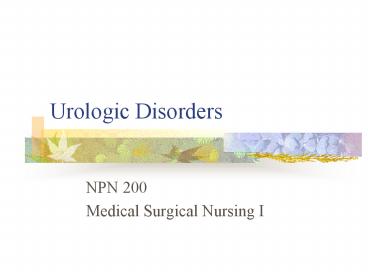Urologic Disorders - PowerPoint PPT Presentation
1 / 19
Title:
Urologic Disorders
Description:
Urologic Disorders NPN 200 Medical Surgical Nursing I Function of the Urinary System Maintain homeostasis Remove metabolic wastes Kidneys regulate the volume, acid ... – PowerPoint PPT presentation
Number of Views:231
Avg rating:3.0/5.0
Title: Urologic Disorders
1
Urologic Disorders
- NPN 200
- Medical Surgical Nursing I
2
Function of the Urinary System
- Maintain homeostasis
- Remove metabolic wastes
- Kidneys regulate the volume, acid base balance,
and electrolyte balance - Responsible for detoxification of the blood
- Aides in erythropoiesis
- Helps to regulate B/P
- Regulates serum potassium, calcium, and phosphate
3
Anatomy and Physiology of Urinary System
- Components of system
- Kidneys
- Ureters
- Bladder
- Urethra
4
Anatomy
5
Data Collection
- Subjective symptoms
- Problems with elimination
- Changes in voiding habits
- Discharge from the urethra
- Pain in the supra-pubic area or back
- Burning sensation on voiding
6
Data Collection
- Objective systems
- Bladder distention (rigid, tender abdomen)
- Urine color, odor, cloudiness, presence of mucus,
sediment, blood, casts, bacteria - Genital irritation
- Amount of urine output
- Electrolyte studies
- Edema of extremities
- Vital signs
7
Data Collection
- History
- Previously normal urinary habits
- Health problems with urinary system
- Presence and location of edema
- Medications
- Food or medicine allergies
- Spasms or pain or both in the bladder region or
flank area - Presence of discharge
8
Physical Examination
- Color of skin and crystals on skin
- Skin turgor
- Look for edema of eyes, sacrum and extremities
- Observe respirations for signs of acidosis, fluid
overload, - Check heart rate and rhythm
- Palpate abdomen for distention and flank for pain
- Examine genitals
9
Diagnostic Exams
- Blood and Urine
- Urinalysis, and culture and sensitivity, glucose,
protein, ketones - Creatinine clearance
- BUN
- Serum creatinine
- Serum electrolytes
- X- rays
- Flat plate of ABD/ KUB
- IVP
- Renal scan
- Renal Angiogram
- MRI
- CT
10
Diagnostic Exams
- Renal biopsy
- Cyctoscopy and retrograde pyleograms
- Cystogram uses dye into bladder
- Cystometrogram evaluates bladder tone
- Bladder scanners (estimates bladder volume
11
Urinary Tract Infections
- More common in women
- Most prevalent nosocomial infection
- Are ascending or descending
- Are described by their location in the tract
- Lower
- Urethritis
- Cystitis
- Prostatitis
- Upper
- Pyelonephritis
- Site and type of bacteria determines treatment
12
Factors Contributing to UTIs
- Invasive procedures catheters
- Obstruction bacteria can grow in pool of urine
- Stones obstructs and irritates mucosa
- Vesicoureteral reflux urine goes up into
kidneys - Diabetes- glucose is food for bacteria
- Gender closes to bacteria
- Age not emptying, neuromuscular, medications
- Sexual activity irritation, increased bacteria
in area
13
Urethritis
- Inflammation of the urethra
- In men
- Usually burning, or difficulty with urination
- Most common cause is an STD
- In women
- Burning, pain and difficulty voiding
- Irritation from vaginal deodorants and bubble bath
- Treatment
- Treat STD
- Treat with antibiotics if bacteria present
- Sitz baths
- Wipe front to back
- Void before and after sex
- Decrease bubble baths
- And vaginal deodorants
14
Cystitis
- Inflammation of the bladder
- More common in women
- S/S burning, frequency, urgency, hematuria,
incontinence, pain, fever, cloudy urine - Diagnosis urinalysis and a CS
- Treatment antibiotics, analgesics, Pyridium,
Urispas
- Interventions
- Sitz baths
- Analgesics
- fluid
- Teach
- avoid tight clothing
- showers over tub
- no caffeine
- wipe front to back
- cranberry juice
15
Interstitial Cystitis
- Chronic inflammation of the bladder
- Cause unknown
- More females
- Severe pelvic pain with urinary frequency and
urgency - Bladder becomes stiff and scarred, with ulcers
and bleeding
- Treatment is mostly out patient
- Pain management
- Antidepressants
- NSAIDS
- Antispasmodics
16
Pyelonephritis
- Acute or chronic (chronic usually caused by long
term UTIs) - One or both kidneys
- May be ascending or blood borne
- May lead to renal failure
17
Pyelonephritis, cont.
- S/S
- High fever, N/V, dysuria, severe back and flank
pain, fatigue - Treatment
- Antibiotics may be long term
- Antispasmodics
- Analgesics
18
Pyelonephritis, cont.
- Nursing Care
- Give pain RX
- Assist with
- ADLs
- Ensure adequate diet
- Provide IV fluids and oral fluids up to 2-3
liters/day
19
Drugs Used for Urinary Tract Disorders
- Diuretics
- Antihypertensives
- Phosphate binders
- Vitamins and mineral supplements
- Antibiotics
- Urinary antiseptics































